Steam turbines: how hot steam turns into electricity
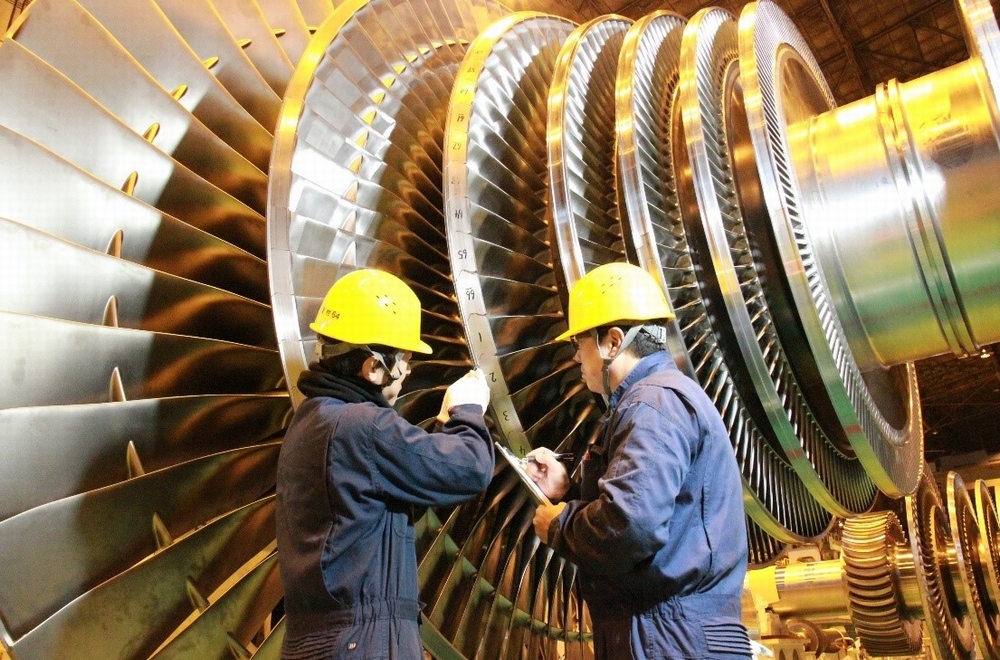
Scientists are still struggling to find the most effective ways to generate current - progress has rushed from the galvanic cells to the first dynamo machines, steam, nuclear, and now solar, wind and hydrogen power plants. In our time, the most massive and convenient way to generate electricity remains a generator driven by a steam turbine.
Steam turbines were invented long before man understood the nature of electricity. In this post, we will describe in a simplified way the structure and operation of the steam turbine, and at the same time we will remember how the ancient Greek scientist was ahead of his time by fifteen centuries, how the revolution in turbine building took place, and why Toshiba believes that a thirty-meter turbine should be manufactured with an accuracy of 0.005 mm.
')
How does a steam turbine
The principle of operation of the steam turbine is relatively simple, and its internal structure has not fundamentally changed for more than a century. To understand the principle of operation of the turbine, consider how a thermal power plant works - a place where fossil fuels (gas, coal, fuel oil) are converted into electricity.
The steam turbine itself does not work, it needs steam to function. Therefore, the power plant begins with the boiler, in which the fuel burns, giving off heat to pipes with distilled water that penetrates the boiler. In these thin tubes, water turns to steam.

The clear scheme of the CHP, which produces electricity and heat for heating homes. Source: Mosenergo
The turbine is a shaft (rotor) with radial blades, like a large fan. Each such disk is equipped with a stator - a similar disk with blades of a different shape, which is fixed not on the shaft, but on the casing of the turbine itself and therefore remains motionless (hence the name - stator).
A pair of one rotating disk with blades and a stator is called a step. There are dozens of steps in one steam turbine - having missed steam in just one step, do not unwind a heavy turbine shaft with a mass of from 3 to 150 tons, so the steps are sequentially grouped to extract the maximum potential energy of steam.
At the entrance to the turbine steam is supplied with a very high temperature and under high pressure. According to steam pressure, there are low (up to 1.2 MPa), medium (up to 5 MPa), high (up to 15 MPa), ultrahigh (15-22.5 MPa) and supercritical (over 22.5 MPa) pressure turbines. For comparison, the pressure inside the champagne bottle is about 0.63 MPa, in the car tire - 0.2 MPa.
The higher the pressure, the higher the boiling point of water, and hence the temperature of the steam. Steam overheated to 550-560 ° C is fed to the turbine inlet! Why so much? As it passes through the turbine, the steam expands to maintain the flow rate and loses temperature, so you need to have a reserve. Why not overheat steam higher? Until recently, this was considered extremely complicated and meaningless — the load on the turbine and the boiler became critical.
Steam turbines for power plants traditionally have several cylinders with blades into which high, medium and low pressure steam is supplied. First, the steam passes through the high-pressure cylinder, spins the turbine, and at the same time changes its output parameters (pressure and temperature decreases), after which it goes into the medium-pressure cylinder, and from there - low. The fact is that the steps for steam with different parameters have different sizes and shape of the blades in order to more effectively extract the energy of steam.
But there is a problem - when the temperature drops to the saturation point, the steam begins to saturate, and this reduces the efficiency of the turbine. To prevent this, in power plants, after the cylinder is high and before it enters the low-pressure cylinder, the steam is reheated in the boiler. This process is called reheating (reheat).
There can be several medium and low pressure cylinders in one turbine. Steam can be supplied to them from the edge of the cylinder, passing all the blades in series, and in the center, diverging to the edges, which equalizes the load on the shaft.
The rotating turbine shaft is connected to an electric generator. In order for the electricity in the network to have the necessary frequency, the generator and turbine shafts must rotate at a strictly defined speed - in Russia, the current in the network has a frequency of 50 Hz, and the turbines operate at 1500 or 3000 rpm.
Simply put, the higher the consumption of electricity produced by the power plant, the stronger the generator resists rotation, so a larger steam flow must be supplied to the turbine. Turbine speed regulators instantly react to changes in load and control the flow of steam so that the turbine maintains constant speed. If the load drops in the network, and the regulator does not reduce the amount of steam supplied, the turbine will rapidly increase and collapse - in the event of such an accident, the blades easily pierce the turbine housing, the roof of the thermal power plant and fly several kilometers away.
How did steam turbines appear
Around the 18th century BC, humanity had already tamed the energy of the elements, turning it into mechanical energy for doing useful work - these were Babylonian windmills. By the II century BC. er in the Roman Empire, water mills appeared, whose wheels were driven by an endless stream of water from rivers and streams. And already in the I century AD. er man tamed the potential energy of water vapor, using it to set in motion a man-made system.
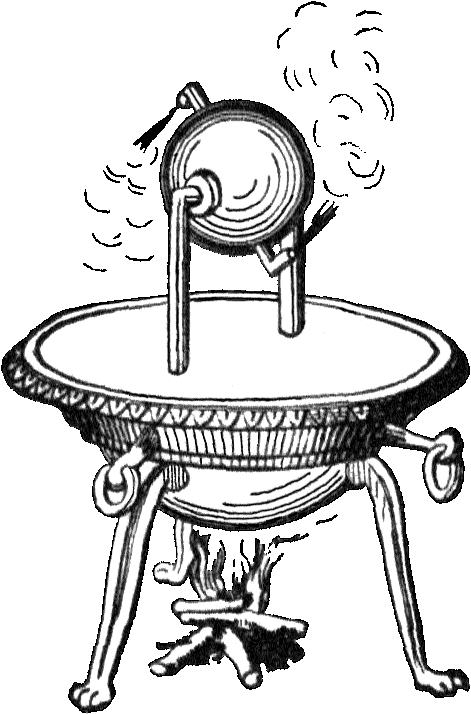
Eolipil Heron of Alexandria is the first and only jet steam turbine for the next 15 centuries. Source: American Mechanical Dictionary / Wikimedia
The Greek mathematician and mechanic Heron of Alexandria described the intricate mechanism of eolipil, which is a sphere fixed on an axis with tubes emanating from it at an angle. The water vapor supplied to the balloon from the boiling boiler forcefully went out of the tubes, causing the balloon to rotate. The car invented by Geron at that time seemed to be a useless toy, but in fact the ancient scientist designed the first steam jet turbine, which could only be assessed after fifteen centuries. The modern replica of eolipil reaches speeds of up to 1,500 revolutions per minute.
In the XVI century, the forgotten invention of Gerona was partially repeated by the Syrian astronomer Takiyuddin ash-Shami, only instead of a ball, a wheel was set in motion, onto which steam was blowing directly from the boiler. In 1629, a similar idea was proposed by the Italian architect Giovanni Branca: the steam jet rotated the impeller, which could be adapted for the mechanization of the sawmill.

Branka's active steam turbine did at least some useful work - “automated” two mortars.
Despite the description by several inventors of machines that convert steam energy into work, the useful realization was still far away - the technology of that time did not allow creating a steam turbine with practically applicable power.
Turbine Revolution
For many years, the Swedish inventor Gustaf Laval had been carrying out the idea of creating a kind of engine that could rotate the axle at an enormous speed - this was required for the operation of a Laval milk separator. While the separator was working from a “manual drive”: the gear system turned 40 revolutions per minute on the handle to 7000 revolutions in the separator. In 1883, Laval succeeded in adapting Heron's eolipil, providing the milk separator with an engine. The idea was good, but the vibrations, the terrible high cost and uneconomical steam turbine forced the inventor to return to the calculations.

The turbine wheel of Laval appeared in 1889, but its design has reached our days almost unchanged.
After years of agonizing trials, Laval was able to create an active single-disk steam turbine. Steam was supplied to a disk with blades of four pipes with nozzles under pressure. Expanding and accelerating in the nozzles, steam hit the blades of the disk and thereby set the disk in motion. Subsequently, the inventor produced the first commercially available turbines with a capacity of 3.6 kW, connected the turbines with dynamos to generate electricity, and also patented many innovations in the design of turbines, including such an integral part of our time as a steam condenser. Despite the difficult start, later Gustaf Laval did well: after leaving his previous company for the production of separators, he founded a joint-stock company and began to increase the capacity of the units.
In parallel with Laval, an Englishman, Sir Charles Parsons, conducted his research in the field of steam turbines, and was able to rethink and successfully complement the ideas of Laval. If the former used in his turbine a single blade disc, then Parsons patented a multi-stage turbine with several successive discs, and later added stators to the design to level the flow.
The Parsons turbine had three successive cylinders for high, medium, and low pressure steam with different blade geometry. If Laval relied on active turbines, then Parsons created jet groups.
In 1889, Parsons sold several hundred of his turbines for the electrification of cities, and five years later an experimental vessel Turbinia was built, which had developed a speed of 63 km / h, which was unattainable for steam engines. By the beginning of the 20th century, steam turbines had become one of the main engines of the rapid electrification of the planet.
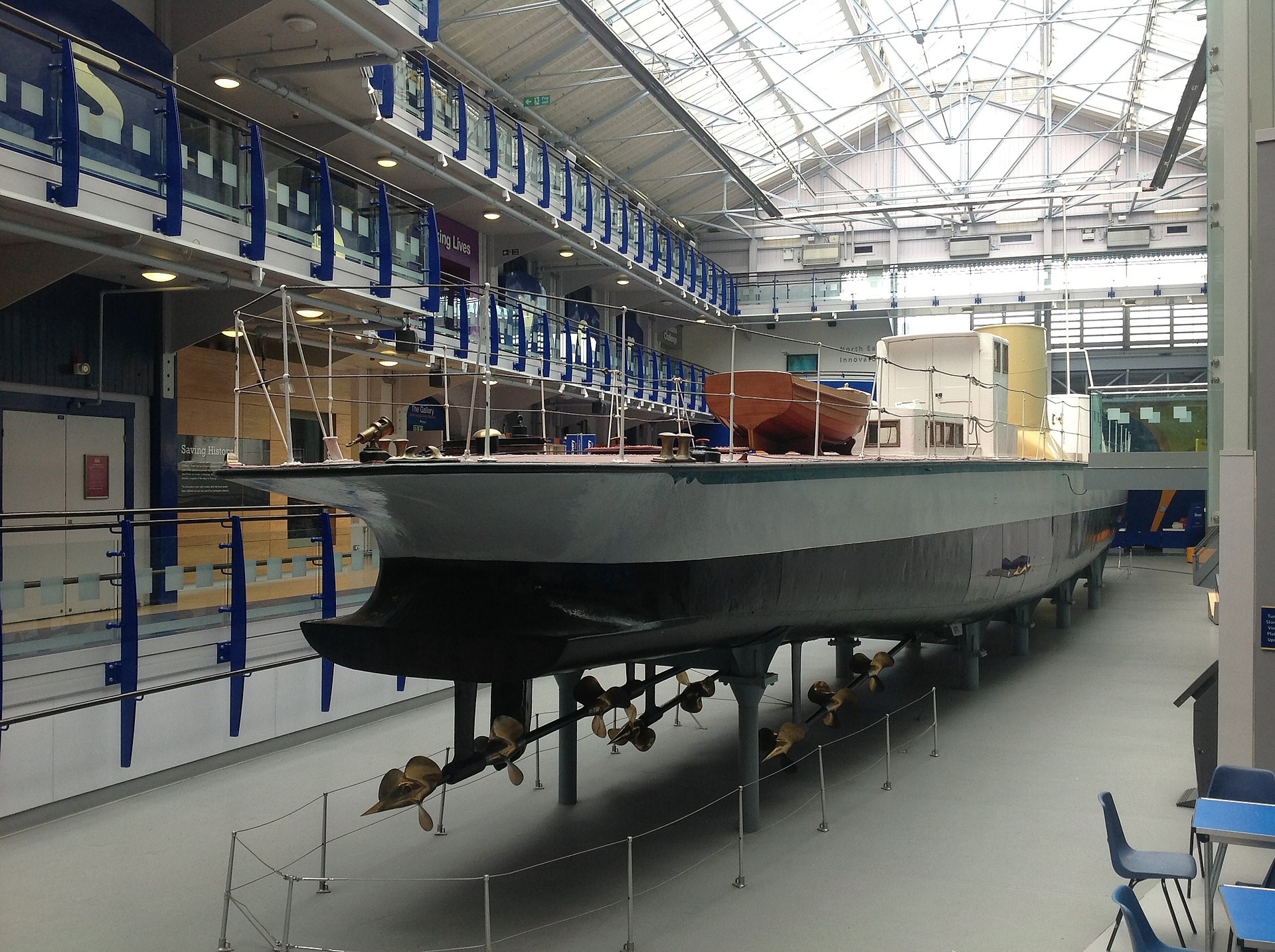
Now "Turbine" is exhibited in the museum in Newcastle. Pay attention to the number of screws. Source: TWAMWIR / Wikimedia
Toshiba Turbines - Century-Length Path
The rapid development of electrified railways and the textile industry in Japan forced the state to respond to the increased electricity consumption by building new power plants. However, work began on the design and production of Japanese steam turbines, the first of which were supplied to the needs of the country as early as the 1920s. Toshiba joined the case (in those years: Tokyo Denki and Shibaura Seisaku-sho).
The first Toshiba turbine was released in 1927, it had a modest power of 23 kW. Two years later, all steam turbines produced in Japan came out of the Toshiba factories, units with a total capacity of 7500 kW were launched. By the way, for the first Japanese geothermal station , opened in 1966, the steam turbines were also supplied by Toshiba. By 1997, all Toshiba turbines had a total capacity of 100,000 MW, and by 2017, deliveries had increased so much that the equivalent capacity was 200,000 MW.
Such demand is due to precision manufacturing. The rotor weighing up to 150 tons rotates at a speed of 3600 revolutions per minute, any imbalance will lead to vibrations and accidents. The rotor is balanced to within 1 gram, and geometric deviations should not exceed 0.01 mm from the target values. CNC equipment helps to reduce deviations in the production of the turbine to 0.005 mm - this is the difference with the target parameters among Toshiba employees is considered good form, although the permissible safe error is an order of magnitude larger. Also, each turbine must pass a stress test at elevated speeds - for units at 3,600 turns, the test provides for acceleration to 4,320 turns.

A good photo for understanding the sizes of low-pressure steam turbine stages. Here is a team of the best masters of the Toshiba Keihin Product Operations factory. Source: Toshiba
Steam Turbine Efficiency
Steam turbines are good because with an increase in their size significantly increases the power generated and efficiency. It is economically more advantageous to install one or several units on a large TPP, from which to distribute electricity over long distances through main networks, than to build local TPPs with small turbines with a capacity from hundreds of kilowatts to several megawatts. The fact is that with a decrease in size and power, the cost of the turbine in terms of kilowatt increases by several times, and the efficiency drops by a factor of two to three.
The electrical efficiency of condensing turbines with reheat is hovering around 35–40%. The efficiency of modern thermal power plants can reach 45%.
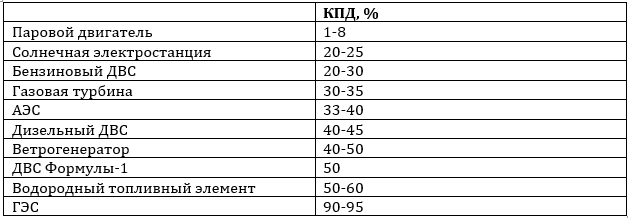
If you compare these figures with the results from the table, it turns out that a steam turbine is one of the best ways to cover large electricity needs. Diesel engines are a “home” story, windmills are expensive and low-power, hydroelectric power stations are very expensive and localized, and hydrogen fuel cells , about which we have already written, are a new and rather mobile way of generating electricity.
Interesting Facts
The most powerful steam turbine: this title can rightly be carried by two products at once - the German Siemens SST5-9000 and the turbine produced by ARABELLE, owned by the American General Electric. Both condensing turbines deliver up to 1,900 MW of power. This potential can be realized only at nuclear power plants.
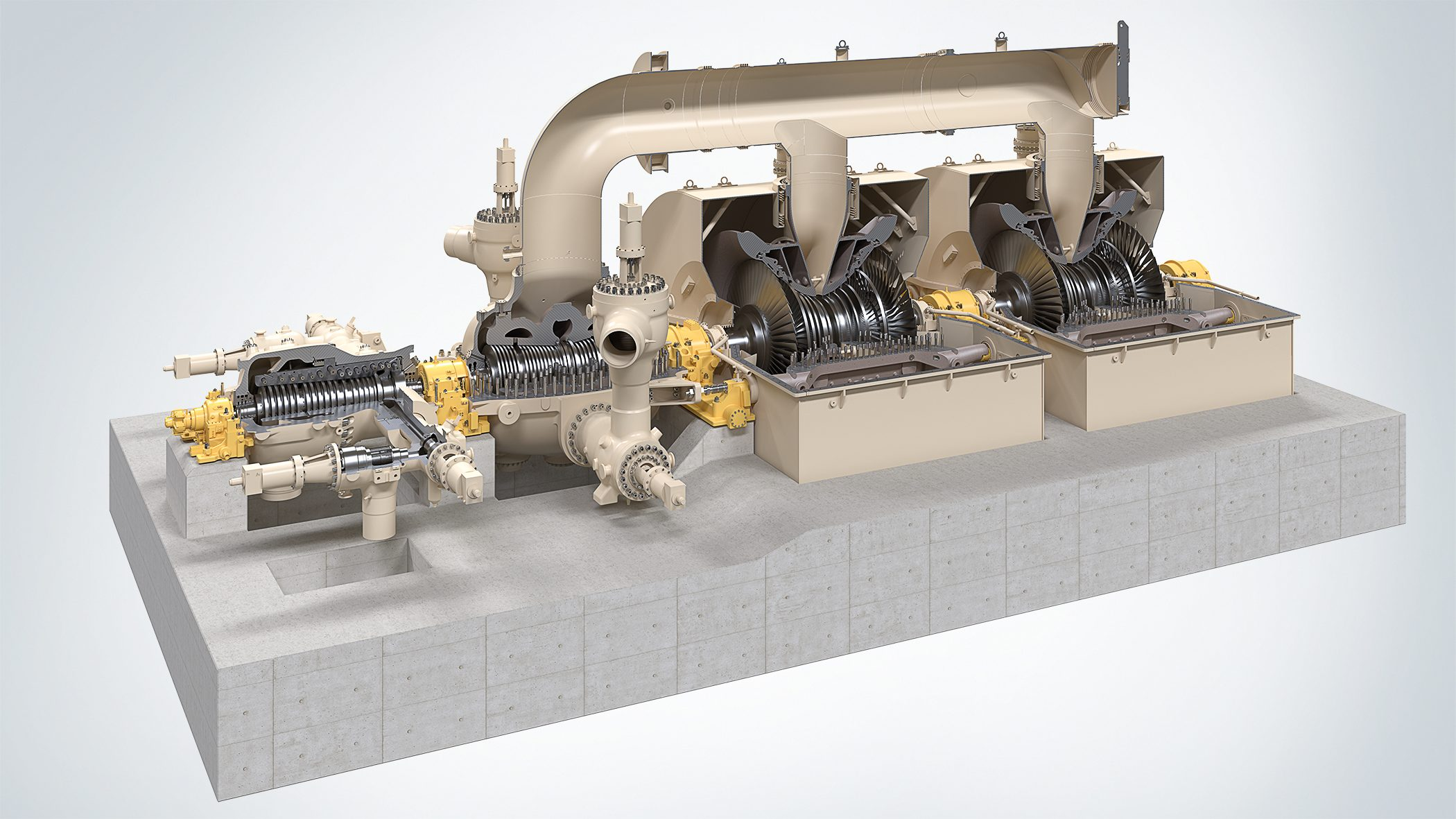
Record turbine Siemens SST5-9000 with a capacity of 1900 MW. Record, but the demand for such power is very small, so Toshiba specializes in units with half the power. Source: Siemens
The smallest steam turbine was created in Russia just a couple of years ago by engineers of the Ural Federal University - PTM-30, just half a meter in diameter, it has a power of 30 kW. The baby can be used to generate electricity locally by utilizing excess steam left over from other processes in order to extract economic benefits from it, rather than lowering it into the atmosphere.
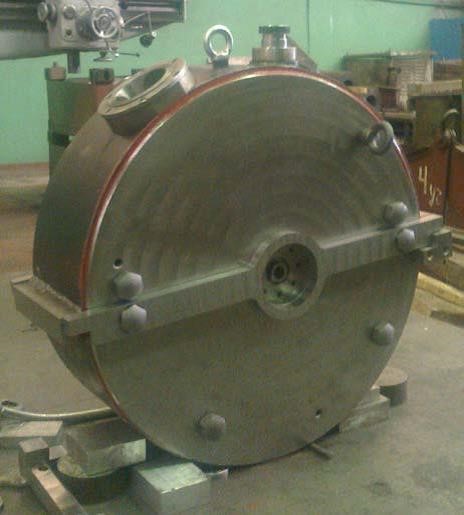
The Russian PTM-30 is the world's smallest steam turbine for generating electricity. Source: UrFU
The most unsuccessful use of a steam turbine is steam turbines, steam locomotives in which steam from the boiler enters the turbine, and then the locomotive moves on electric motors or due to mechanical transmission. Theoretically, the steam turbine provided many times greater efficiency than a regular steam locomotive. In fact, it turned out that the steam-turbine carrier shows its advantages, such as high speed and reliability, only at speeds above 60 km / h. At lower speeds, the turbine consumes too much steam and fuel. The US and European countries experimented with steam turbines on locomotives, but terrible reliability and questionable efficiency reduced the life of steam turbine locomotives as a class to 10–20 years.

Coal steam turbines C & O 500 broke almost every trip, because of what was already a year after the release was sent for scrap. Source: Wikimedia
Source: https://habr.com/ru/post/445556/
All Articles